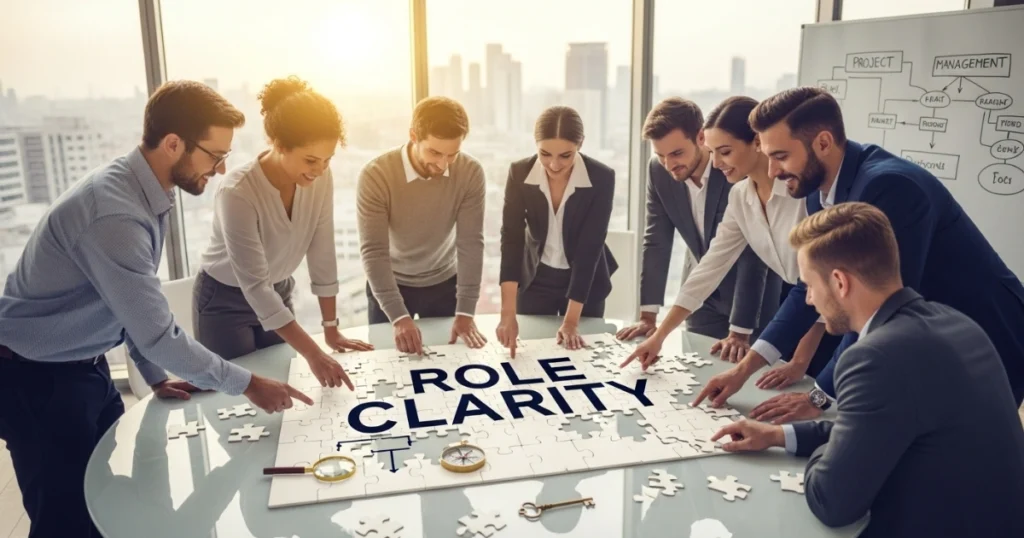
AI Content Creation
How to Grow Influence with Role Clarity

Contents
- 1 Why Role Clarity Matters for Influence
- 2 Strategies to Grow Influence with Role Clarity
- 2.1 1. Define Roles Clearly from the Start
- 2.2 2. Communicate Expectations Regularly
- 2.3 3. Align Roles with Organizational Goals
- 2.4 4. Leverage Feedback for Role Refinement
- 2.5 5. Empower Through Training and Development
- 2.6 6. Use Technology to Reinforce Role Clarity
- 2.7 7. Lead by Example
- 2.8 8. Address Role Ambiguity Promptly
- 2.9 9. Foster a Culture of Role Accountability
- 2.10 10. Continuously Evaluate and Adjust Roles
- 3 Overcoming Common Challenges in Achieving Role Clarity
- 4 Case Studies: Role Clarity Driving Influence
- 5 Measuring the Impact of Role Clarity on Influence
To grow influence with role clarity, individuals and organizations must prioritize defining responsibilities and expectations with precision. In today’s fast-paced world, where collaboration and leadership are critical, unclear roles can lead to confusion, inefficiency, and missed opportunities. By establishing clear roles, you empower yourself and your team to build trust, enhance communication, and amplify impact. This article explores actionable strategies to achieve influence through role clarity, offering insights for professionals, leaders, and teams aiming to maximize their potential in 2025 and beyond.
Why Role Clarity Matters for Influence
Role clarity refers to the precise understanding of an individual’s responsibilities, authority, and expectations within a team or organization. Without it, miscommunication and inefficiency can erode trust and hinder progress. Here’s why role clarity is essential for growing influence:

Builds Trust and Credibility
When everyone understands their roles, trust flourishes. Clear expectations prevent overlap and reduce conflicts, allowing individuals to demonstrate reliability. For instance, a project manager who clearly defines team members’ tasks fosters accountability, which strengthens their leadership presence.
Enhances Decision-Making
With role clarity, decision-making becomes streamlined. Individuals know their scope of authority, enabling faster, more confident choices. This efficiency boosts influence, as others perceive decisive individuals as competent leaders.
Improves Collaboration
Teams with well-defined roles collaborate more effectively. Each member knows their contribution, reducing friction and aligning efforts toward shared goals. As a result, the team’s collective influence grows, as does the individual’s reputation within it.
Amplifies Accountability
Role clarity ensures everyone knows who is responsible for what. This transparency fosters accountability, which enhances influence by showcasing reliability and commitment.
Strategies to Grow Influence with Role Clarity
To maximize influence, implement these practical strategies to achieve and maintain role clarity in your professional environment.

1. Define Roles Clearly from the Start
Start by outlining responsibilities for every team member. Use tools like job descriptions, RACI charts (Responsible, Accountable, Consulted, Informed), or role-specific KPIs to clarify expectations. For example, a marketing team might assign content creation to one member, analytics to another, and campaign management to a third. Clear definitions prevent overlap and ensure everyone knows their lane.
Actionable Tip: Hold a kickoff meeting for new projects to discuss roles. Document agreements and share them with the team to avoid confusion later.
2. Communicate Expectations Regularly
Role clarity requires ongoing communication. Regular check-ins, such as weekly meetings or one-on-one sessions, ensure alignment. Use these opportunities to revisit roles, address ambiguities, and reinforce expectations. For instance, a manager might clarify that a team member’s role includes client follow-ups but not contract negotiations.
Transition: Moreover, consistent communication builds a culture of transparency, which directly supports influence.
3. Align Roles with Organizational Goals
To grow influence with role clarity, ensure individual roles align with broader objectives. When team members see how their work contributes to the organization’s success, they feel empowered and motivated. For example, a sales representative who understands how their targets support company revenue goals is more likely to take ownership and influence outcomes.
Actionable Tip: Create a visual roadmap linking individual roles to company objectives. Share this during onboarding or team meetings to reinforce purpose.
4. Leverage Feedback for Role Refinement
Feedback is critical for refining roles and enhancing influence. Encourage team members to share insights on role overlaps or gaps. For instance, if two employees inadvertently handle the same task, use feedback to reassign responsibilities clearly. This process not only improves efficiency but also positions you as a leader who values input.
Transition: In addition, feedback fosters a collaborative environment, which amplifies your influence further.
5. Empower Through Training and Development
Invest in training to ensure team members are equipped for their roles. When individuals feel confident in their skills, they perform better and gain influence. For example, offering leadership workshops for mid-level managers clarifies their decision-making authority, boosting their ability to lead effectively.
Actionable Tip: Identify skill gaps during performance reviews and provide targeted training to address them. This investment signals trust in employees’ potential.
6. Use Technology to Reinforce Role Clarity
Modern tools like project management software (e.g., Asana, Trello) can reinforce role clarity by assigning tasks and tracking progress. These platforms provide visibility into who is responsible for what, reducing confusion. For instance, a design team using Trello can assign specific cards to designers, ensuring no overlap in creative tasks.
Transition: Furthermore, technology streamlines processes, allowing you to focus on building influence through leadership.
7. Lead by Example
As a leader, model role clarity in your actions. Clearly communicate your responsibilities and boundaries to your team. For example, a CEO might delegate operational tasks to a COO while focusing on strategic vision. By demonstrating role clarity, you inspire others to do the same, enhancing your influence.
Actionable Tip: Share your role description during team meetings to set a precedent for transparency.
8. Address Role Ambiguity Promptly
When ambiguity arises, address it immediately to prevent confusion. For instance, if two team members claim ownership of a task, meet with them to clarify responsibilities and update role definitions. Swift resolution prevents frustration and maintains team cohesion.
Transition: Consequently, proactive problem-solving strengthens your reputation as a decisive leader.
9. Foster a Culture of Role Accountability
Encourage a culture where team members take ownership of their roles. Recognize and reward those who consistently meet expectations. For example, publicly acknowledging a team member’s successful project delivery reinforces their role’s importance and boosts their influence.
Actionable Tip: Implement a recognition program to highlight individuals who exemplify role clarity and accountability.
10. Continuously Evaluate and Adjust Roles
Roles evolve as organizations grow. Regularly assess whether current roles align with team and company goals. For instance, a startup might initially have a single employee handling marketing and sales, but as it scales, these roles should split to maintain clarity and efficiency.
Transition: Ultimately, adaptability ensures long-term role clarity and sustained influence.
Overcoming Common Challenges in Achieving Role Clarity
While role clarity is powerful, challenges can arise. Here’s how to address them to maintain influence:

Challenge 1: Resistance to Change
Some team members may resist new role definitions, especially in established teams. Overcome this by explaining the benefits of clarity, such as reduced stress and improved collaboration. Involve them in the process to gain buy-in.
Challenge 2: Overlapping Responsibilities
When roles overlap, conflicts can occur. Use tools like RACI charts to map out responsibilities clearly. For example, in a software development team, clarify whether the front-end or back-end developer handles API integration.
Challenge 3: Lack of Communication
Poor communication can undermine role clarity. Foster open dialogue through regular team meetings and feedback channels. Encourage questions about roles to address confusion early.
Challenge 4: Evolving Organizational Needs
As organizations grow, roles may become outdated. Conduct quarterly role reviews to ensure alignment with current goals. For instance, a company expanding internationally might create a new role for global market analysis.
Case Studies: Role Clarity Driving Influence
Case Study 1: Tech Startup Success
A tech startup struggled with missed deadlines due to unclear roles. By implementing RACI charts and weekly check-ins, the leadership team clarified responsibilities, resulting in a 30% increase in project delivery efficiency. The CEO’s influence grew as employees trusted her ability to streamline operations.
Case Study 2: Corporate Team Turnaround
A corporate marketing team faced internal conflicts over task ownership. The manager introduced role-specific KPIs and regular feedback sessions, reducing overlap and boosting team morale. The manager’s influence soared as the team hit its quarterly targets consistently.
Measuring the Impact of Role Clarity on Influence
To gauge success, track these metrics:

- Team Productivity: Measure output before and after implementing role clarity strategies.
- Employee Satisfaction: Conduct surveys to assess whether clear roles improve morale.
- Project Success Rates: Monitor the percentage of projects completed on time.
- Leadership Perception: Use 360-degree feedback to evaluate how role clarity enhances your influence.
Conclusion
Growing influence with role clarity is a powerful strategy for professionals and organizations in 2025. By defining roles, communicating expectations, and fostering accountability, you can build trust, streamline collaboration, and amplify impact. Start by assessing current roles, leveraging tools, and addressing challenges promptly. With consistent effort, role clarity will not only enhance your influence but also position you as a trusted leader in any setting. Take the first step today—clarify one role in your team and watch the ripple effect of influence unfold.


How to Grow Influence with Role Clarity
Updated on August 3, 2025
Read More